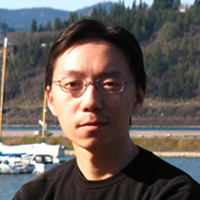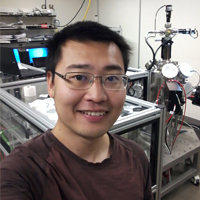When Slater Meets Mott

Born five years and an ocean apart at the turn of the 20th Century, both John Slater and Sir Nevill Francis Mott were known for their contributions to understanding electronic structure (Mott would win a Nobel Prize for his work in 1977). Here in 2020, Assistant Professor Jian Liu (left) and his research group studied the crossover regime of insulators named for these physicists, with the results published in Physical Review Letters.
Insulators are notoriously poor conductors of heat or electricity, typically because their electrons aren’t very mobile. Graduate Student Junyi Yang (pictured right) was the first author on the PRL paper and explained the difference between Slater and Mott insulators and why they’re of interest.

In a Slater insulator, electrons are weakly correlated and mobile at finite temperatures but turn out to have an insulating ground state at low temperatures driven by antiferromagnetic (AFM) order, where the electrons are localized because they would like to spin oppositely to their neighboring electrons. In a Mott insulator, the interaction between electrons is so strong that they’re "frozen" onto their parent atoms, and the material remains insulating at all times, even above the AFM ordering temperature.
"Slater and Mott insulators are merely two cases in the extreme limit of electron correlation," Yang said. "When the electron correlation is neither weak nor strong, then the properties of the system become less trivial. This regime is often referred to as the Slater-Mott crossover regime where the electron coupling is intermediate. Exploration within this regime helps (scientists) understand the relation between electron correlation and electronic and magnetic properties of the condensed matter systems. The study can be also beneficial in understanding fundamental physics like many body effects and promising applications like high-temperature superconductor cuprates."
Liu pointed out that typically in physics you have a system with two types of interactions that have different, competing energies, so making one much bigger than the other leads you to a very different state.
"You tune the relative strength of the interactions and try to go from one limit to another limit," he said.
In this case, the situation is unusual because at zero temperature the ground state is the same.
"The difference does not lie in the ground state but in the finite temperature state," he explained. "That’s the point that a lot of people miss."
In this work, physicists grew a “superlattice,” alternating repeating layers of SrIrO3 (strontium, iridium, and oxygen) and SrTiO3, (strontium, titanium, and oxygen) as one unit on three different substrates, or base layers. They were able to tune the electrons in this system through epitaxial strain—essentially compressing the superlattices as they grew them.
"Epitaxy is like LEGOs," Liu explained. "They stack on top of each other. The holes and the pins match. If you change the size of the LEGO, if you change the spacing, and you try to stack the same block on top of the other, those pins and holes don’t match. The only way to make it match is to stretch it out: compress it."
The idea is to tweak the correlation between electrons—strong or weak—which is governed by what’s known as Coulomb repulsion.
"It depends on the size of the orbital, essentially," Liu said. "If that ‘room’ is very tiny and they have to interact with each other a lot, then the Coulomb repulsion is strong. If the ‘room’ is very big—it’s like a football field—then of course they don’t run into each other. That’s weak Coulomb repulsion."
The point of straining the system in this experiment, he said, was "trying to control the spacing between the atoms so that we control the size of the orbital. That way we eventually control the degree of the Coulomb repulsion. But it’s only one facet of this whole problem. The other problem is how many electrons are in that room? We control the size of the room, but we’re not yet controlling the number of electrons."
To do that would require carrier doping—adding an electron or a hole where one should be.
For future studies, Yang said that epitaxial engineering can further allow us to replace the SrTiO3 layer with LaTiO3 (lanthanum, titanium, and oxygen); thus, we are able to carrier dope the system. Because the system is analogous to the parent compound of high-temperature superconductor cuprates, some exotic physics states may be expected.
The results appear in Strain-Modulated Slater-Mott Crossover of Pseudospin-Half Square-Lattice in (SrIrO3)1/(SrTiO3)1 Superlattices. UT authors are Junyi Yang (graduate student and lead author), Lin Hao (postdoctoral research associate), Lincoln Chair Professor Cristian Batista, and Assistant Professor Jian Liu. Associate Professor Haidong Zhou provided experimental assistance.